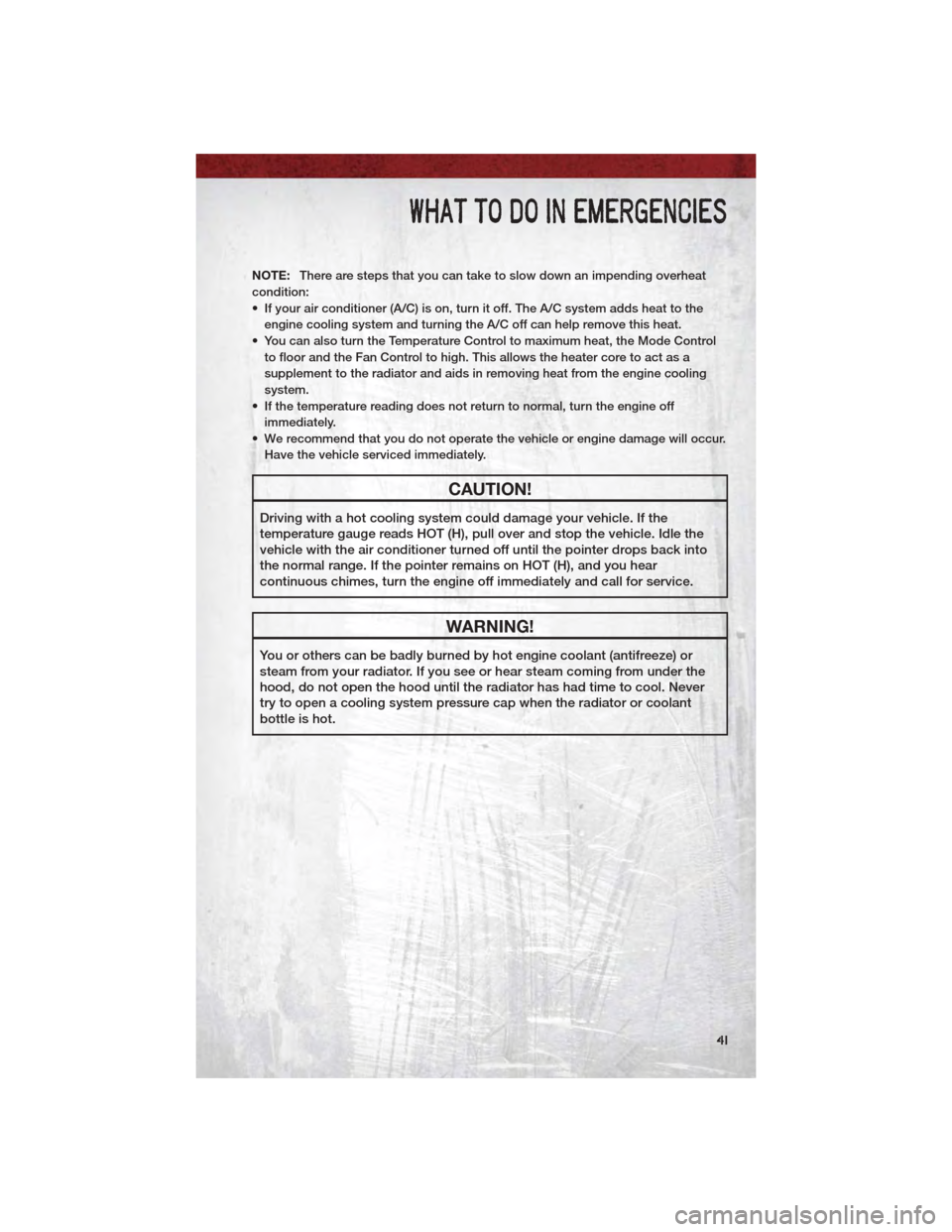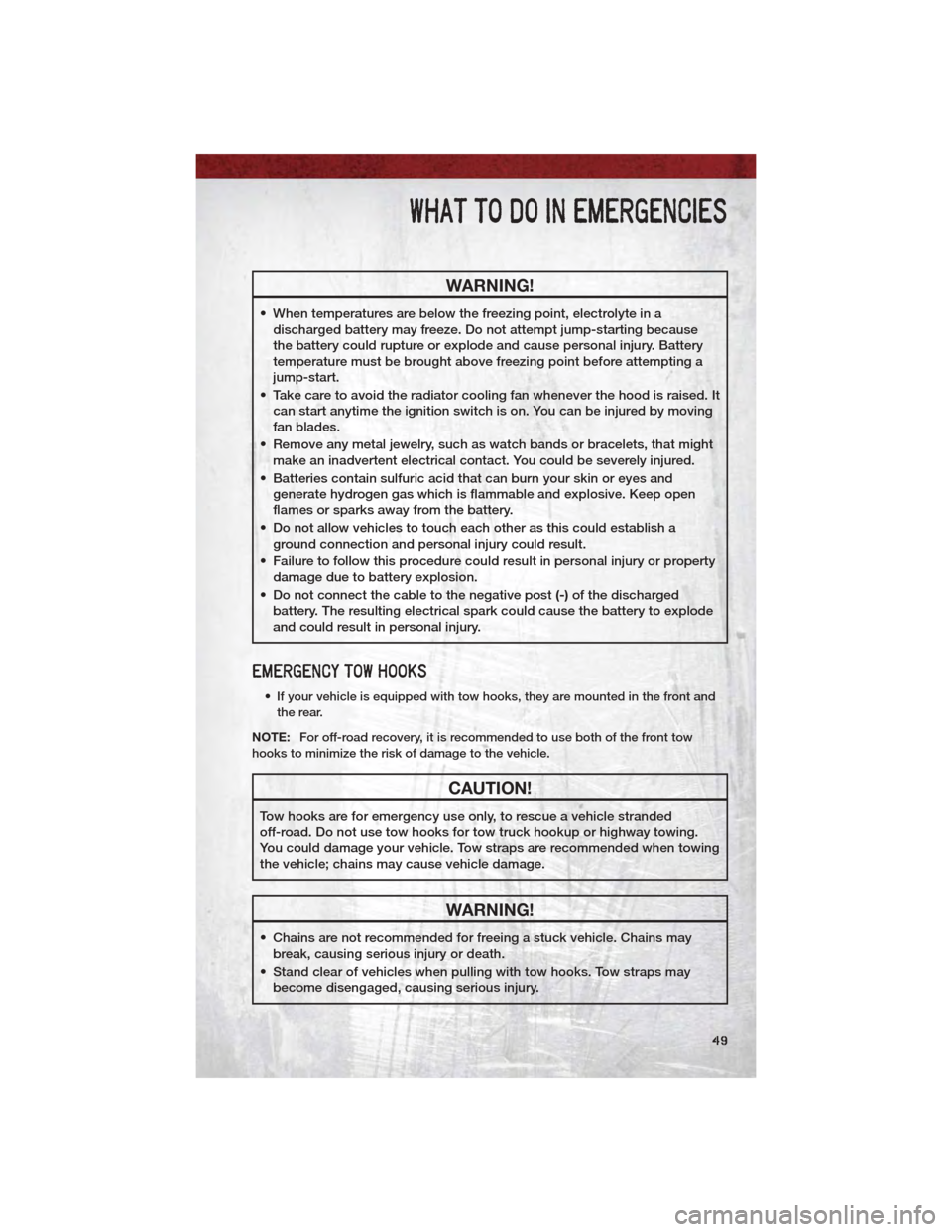radiator DODGE DAKOTA 2011 3.G User Guide
[x] Cancel search | Manufacturer: DODGE, Model Year: 2011, Model line: DAKOTA, Model: DODGE DAKOTA 2011 3.GPages: 76, PDF Size: 4.62 MB
Page 43 of 76

NOTE:There are steps that you can take to slow down an impending overheat
condition:
• If your air conditioner (A/C) is on, turn it off. The A/C system adds heat to the engine cooling system and turning the A/C off can help remove this heat.
• You can also turn the Temperature Control to maximum heat, the Mode Control to floor and the Fan Control to high. This allows the heater core to act as a
supplement to the radiator and aids in removing heat from the engine cooling
system.
• If the temperature reading does not return to normal, turn the engine off immediately.
• We recommend that you do not operate the vehicle or engine damage will occur. Have the vehicle serviced immediately.
CAUTION!
Driving with a hot cooling system could damage your vehicle. If the
temperature gauge reads HOT (H), pull over and stop the vehicle. Idle the
vehicle with the air conditioner turned off until the pointer drops back into
the normal range. If the pointer remains on HOT (H), and you hear
continuous chimes, turn the engine off immediately and call for service.
WARNING!
You or others can be badly burned by hot engine coolant (antifreeze) or
steam from your radiator. If you see or hear steam coming from under the
hood, do not open the hood until the radiator has had time to cool. Never
try to open a cooling system pressure cap when the radiator or coolant
bottle is hot.
WHAT TO DO IN EMERGENCIES
41
Page 51 of 76

WARNING!
• When temperatures are below the freezing point, electrolyte in adischarged battery may freeze. Do not attempt jump-starting because
the battery could rupture or explode and cause personal injury. Battery
temperature must be brought above freezing point before attempting a
jump-start.
• Take care to avoid the radiator cooling fan whenever the hood is raised. It can start anytime the ignition switch is on. You can be injured by moving
fan blades.
• Remove any metal jewelry, such as watch bands or bracelets, that might make an inadvertent electrical contact. You could be severely injured.
• Batteries contain sulfuric acid that can burn your skin or eyes and generate hydrogen gas which is flammable and explosive. Keep open
flames or sparks away from the battery.
• Do not allow vehicles to touch each other as this could establish a ground connection and personal injury could result.
• Failure to follow this procedure could result in personal injury or property damage due to battery explosion.
• Do not connect the cable to the negative post (-)of the discharged
battery. The resulting electrical spark could cause the battery to explode
and could result in personal injury.
EMERGENCY TOW HOOKS
• If your vehicle is equipped with tow hooks, they are mounted in the front and
the rear.
NOTE: For off-road recovery, it is recommended to use both of the front tow
hooks to minimize the risk of damage to the vehicle.
CAUTION!
Tow hooks are for emergency use only, to rescue a vehicle stranded
off-road. Do not use tow hooks for tow truck hookup or highway towing.
You could damage your vehicle. Tow straps are recommended when towing
the vehicle; chains may cause vehicle damage.
WARNING!
• Chains are not recommended for freeing a stuck vehicle. Chains may break, causing serious injury or death.
• Stand clear of vehicles when pulling with tow hooks. Tow straps may become disengaged, causing serious injury.
WHAT TO DO IN EMERGENCIES
49